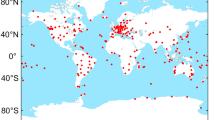Abstract
In this paper, the problem of joint estimation of carrier and sampling frequency offsets is considered, for IEEE 802.11ac-based OFDM wireless LAN systems, based on the guard interval and two long symbols (GI2L) in the preamble of a packet. The measurement model of the GI2L is developed, in the presence of both carrier and sampling frequency offsets. One method based on the GI2L is proposed and compared with some existing relevant methods based on long symbol/data symbols. An improved performance, measured by estimation error and bit error rate, is achieved by this method, at a similar computational load.








Similar content being viewed by others
Notes
This channel model can also include the effect of transmit and receive filters.
\(\psi\) under this assumption is called fractional CFO. This assumption is valid if the frequency accuracies of oscillators in transmitter and receiver satisfy the IEEE 802.11ac recommendation. Otherwise, one has to estimate the integer part of CFO from the demodulated measurement as in [16], or from the MUSIC spectrum as in [17] using data symbols and/or long symbols. One subcarrier spacing is equal to 20 MHz/64 = 312.5 kHz.
A stationary channel is a channel which is invariant across various simulation runs.
Among 52 phases, the averaged number of phases in that range is 51.994 at \(\hbox {SNR} = 40\,\hbox {dB}\), 51.95 at \(\hbox {SNR} = 30\,\hbox {dB}\), 51.514 at \(\hbox {SNR} = 20\,\hbox {dB}\) and 47.652 at \(\hbox {SNR} = 10\,\hbox {dB}\), over 3000 simulation runs.
References
Speth, M., Fechtel, S. A., Fock, G., & Meyr, H. (1999). Optimum receiver design for wireless broadband systems using OFDM—Part I. IEEE Transactions on Communications, 47(11), 1668–1677.
Liu, S., & Chong, J. (2002). A study of joint tracking algorithms of carrier frequency offset and sapling clock offset for OFDM-based WLANs. In Proceedings of IEEE international conference on communications, circuits and systems, Chengdu, China (vol. 1, pp. 109–113).
Zheng, Z.-W. (2007). Robust channel estimation for the OFDM-based WLAN systems with imperfect synchronization. Wireless Personal Communication, 43(2), 703–709.
Tsai, P., Kang, H., & Chieuh, T. (2005). Joint weighted least-squares estimaion of carrier-frequency offset and timing offset for OFDM systems over multipath fading channels. IEEE Transactions on Vehicular Technology, 54(1), 211–223.
Morelli, M., & Moretti, M. (2010). Fine carrier and sampling frequency synchronization in OFDM systems. IEEE Transactions on Wireless Communication, 9(4), 1514–1524.
Murin, Y., & Dabora, R. (2015). Low complexity estimation of carrier and sampling frequency offsets in burst-mode OFDM systems. Wireless Communications and Mobile Computing, 16(9), 1018–1034.
Wang, X., & Hu, B. (2014). A low-complexity ML estimator for carrier and sampling frequency offsets in OFDM systems. IEEE Communications Letters, 18(3), 503–506.
Kim, Y., & Lee, J. (2011). Joint maximum likelihood estimation of carrier and sampling frequency offsets for OFDM systems. IEEE Transactions on Broadcasting, 57(2), 277–283.
Simoens, S., Buzenac, V., & de Courville, M. (2000). A new method for joint cancellation of clock and carrier frequency offsets. In Proceedings of vehicular technology conference (VTC 2000 Spring), (vol. 1, pp. 390–394). Tokyo: Spring.
Häring, L., Bieder, S., & Czylwik, A. (2006). Residual carrier and sampling frequency synchronization in multiuser OFDM systems. In Proceedings of vehicular technology conference (VTC 2006 Spring), Melbourne (pp. 1937–1941).
Oberli, C. (2007). ML-based tracking algorithms for MIMO OFDM. IEEE Transactions on Wireless Communications, 6(7), 2630–2639.
Nguyen-Le, H., Le-Ngoc, T., & Ko, C. C. (2009). RLS-based joint estimation and tracking of channel response, sampling, and carrier frequency offsets for OFDM. IEEE Transactions on Broadcasting, 55(1), 84–94.
Moose, P. H. (1994). A technique for orthogonal division multiplexing frequency offset correction. IEEE Transactions on Communications, 42(10), 2908–2914.
Cheng, Q. (2013). Performance study of residual carrier frequency offset estimation methods in OFDM WLAN systems. Digital Signal Processing, 23(3), 981–993.
Wu, Y., Yip, K., Ng, T., & Serpedin, E. (2005). Maximum likelihood symbol synchronization for IEEE 802.11a WLANs in unknown frequency-selective fading channels. IEEE Transactions on Wireless Communication, 4(6), 2751–2763.
Speth, M., Fechtel, S. A., Fock, G., & Meyr, H. (2001). Optimum receiver design for wireless broadband systems using OFDM—Part II. IEEE Transactions on Communication, 49(4), 571–578.
Cheng, Q. (2005). Carrier frequency offset estimation in OFDM wireless LAN systems. In Proceedings of 2005 Asia-Pacific conference on communications, Perth (pp. 1019–1023).
Duhamel, P., & Hollmann, H. (1984). Split radix FFT algorithm. Electronics Letters, 20(1), 14–16.
Viberg, M., & Swindlehurst, A. L. (1994). A Bayesian approach to auto-calibration for parametric array signal processing. IEEE Transactions on Signal Processing, 42(12), 3495–3507.
Liu, J., & Li, J. (2004). Parameter estimation and error reduction for OFDM based WLANs. IEEE Transactions on Mobile Computing, 3(2), 152–163.
IEEE Std 802.11ac - 2013 IEEE Standard for information technology—Telecommunications and information exchange between systems—Local and metropolitan area networks—Specific requirements—Part 11: Wireless LAN medium access control (MAC) and physical layer (PHY) specifications—Amendment 4: Enhancements for very high throughput for operation in bands below 6 GHz.
Perahia, E., & Stacey, R. (2013). Next generation wireless LANs: 802.11n and 802.11ac. Cambridge: Cambridge University Press.
IEEE Std. 802.11a-1999 (R2003). (1999). Wireless LAN medium access (MAC) and physical layer (PHY) specifications: High sped physical layer in 5GHz band.
Author information
Authors and Affiliations
Corresponding author
Appendix: Robust Channel Estimation Using GI2L
Appendix: Robust Channel Estimation Using GI2L
Define
Then the noisy GI2L samples in (10) can be written in a matrix-vector form as \(\hat{\mathbf{y}} = {\mathbf{A}}_{\psi ,\zeta } {{\mathcal {H}}} + {\varvec{\xi }}.\) For the noisy GI2L and given a pair of estimates \({\hat{\psi }}={\hat{\psi }}_{gl}+{\hat{\epsilon }},{\hat{\zeta }}\), where \({\hat{\epsilon }},{\hat{\zeta }}\) are given by a fine-tuning method, the channel response vector \({{\mathcal {H}}}\) can be estimated as
Expressions (11) and (12) of [3] can also be used to calculate an estimate of \(H_{k_{1}}\). The resulting estimates are found to be much less accurate than that in (156) and thus are not used in this paper.
Rights and permissions
About this article
Cite this article
Cheng, Q. Joint Estimation of Carrier and Sampling Frequency Offsets Using OFDM WLAN Preamble. Wireless Pers Commun 98, 2121–2161 (2018). https://doi.org/10.1007/s11277-017-4967-8
Published:
Issue Date:
DOI: https://doi.org/10.1007/s11277-017-4967-8




